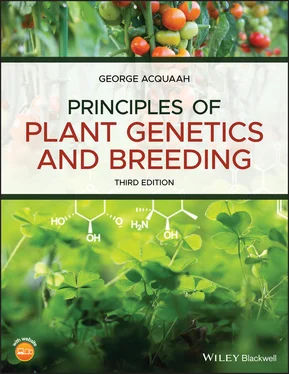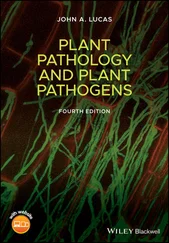2.2.2 The “no name” breeder
One of the common practices or traditions in modern plant breeding is to refer to germplasm whose source, name, or breeding history is unknown as simply “No Name.” This casual acknowledgment appears to absolve the breeder of any deliberate and willful infringement on intellectual property. These nameless products are modern‐day examples of cultivars that have fallen victim to improper record keeping.
2.3 Plant manipulation efforts by the early civilizations
Archeological and historical records from early civilizations indicate that some of these communities engaged in rudimentary plant manipulations, albeit in the dark, without knowledge of plant heredity. Whereas it would not be farfetched to assume that, just like farmers of the early civilizations who domesticated crops species would have also continued their selection practices to produce farmer‐selected varieties, evidence of deliberate plant manipulation for the purposes of improvement are few. Archeological findings occasionally reveal some ancient practices that indicate plant manipulation beyond phenotypic selection among natural variability occurred. Babylonians are said to have perceived the role of pollen in successful fruit production and applied it to the pistils of female date palms to produce fruit. The Assyrians did likewise in about 870 BCE, artificially pollinating date palms.
2.4 Early pioneers of the theories and practices of modern plant breeding
Plant breeding as we know it today began in earnest in the nineteenth century. Prior to this era, a number of groundbreaking discoveries and innovations paved the way for scientific plant manipulation. Some of the early pioneers of plant breeding include:
Rudolph CamerariusRudolph Camerarius was a professor of philosophy at the University of Tubingen in Germany. He conducted research that contributed to establishing sexual differentiation, defining the male and female reproductive parts of the plant. His seminal work was published in 1694 in a letter to a colleague, De sexu plantarum (On the sex of plants). Camerarius's work also described the functions of the reproductive parts in fertilization and showed that pollen is required for this key process in heredity.
Joseph Gottlieb KoelreuterGerman botanist, J. G. Koelreuter became professor of natural history and director of the botanical gardens in Karlsruhe in 1764. He was the pioneer in the application of the discovery of sex in plants as a vehicle for their genetic manipulation. He observed that the hybrid offspring generally resembled the parent that supplied the pollen as closely as the parent on which seed was borne. Koelreuter conducted the first systematic experiments in plant hybridization, using the tobacco plant as subject. He recognized the role of insects and wind in pollination of flowers, and also conducted experiments to study artificial fertilization and development in tobacco plants. The golden rain tree genus (Koelreuteria) is named in his honor.
Louis de VilmorinLouis de Vilmorin was a noted French seedsman. His experiments in heredity contributed to our understanding of the cause of variation. Vilmorin conducted studies in plant improvement in vegetables using a method called genealogical selection, which is the modern breeding equivalent of progeny testing. He recognized that one could develop new varieties of plants by selecting certain characteristics which would then be transmitted through genealogy to the progeny. In 1856, he published his “Note on the Creation of a New Race of Beetroot and Considerations on Heredity in Plants,” which laid the theoretical groundwork for the modern seed‐breeding industry. Modern‐day Vilmorin is a major player in the global seed industry, which along with its international subsidiaries is ranked among the top five largest seed companies in the world. The company is also credited with producing the first seed catalog for farmers and academics, among other significant publications.
Thomas Andrew KnightThis British horticulturalist and botanist conducted basic research in plant physiology that led to the discovery of the phenomenon of geotropism, the effects of gravity on seedlings. He also showed how decay in fruit trees was transmitted through grafting. In terms of practical crop improvement, Knight conducted research in the breeding of horticultural plants, including strawberries, cabbages, peas, apples, and pears. The “Downton” strawberry which he developed is noted in the pedigree of most of the important modern strawberries. He is credited with pioneering work in the science of fruit breeding. In 1797 he published Treatise on the culture of apple and pear. Knight is also said to have demonstrated segregation for seed characters of the garden pea, but, unfortunately did not offer an explanation for the event as Mendel eventually did.
Carl LinnaeusA Swedish botanist, physician, and zoologist, Carl Linnaeus is most noted for his work in plant taxonomy, which led to the development of his enduring conventions for naming living organisms, the universally accepted binomial nomenclature, also called Linnaean taxonomy or the scientific classification of organisms. The binomial nomenclature classifies nature within a hierarchy, assigning a two‐part name to an individual, a genus, and a species (specific epithet). His work was published in his most noted publication Species Plantarum. There are specific rules and guidelines for writing scientific names, which are in Latin, the genus beginning with a capital letter while the species is not; being non‐English, the name is italicized (or underlined), for example, Zea mays (corn). Further, the genus can stand alone, but not the species (e.g. Zea, Zea sp., or Z. mays).
Charles DarwinCharles Robert Darwin was an English naturalist, with one of the most recognizable names of all time, because of his work that led to one of the most enduring theories ever, the theory of evolution. He proposed what is sometimes called the unifying theory of life sciences that all species of life have evolved over time from a common ancestor. The process of evolution is extremely slow, requiring thousands and even millions of years to bring about the gradual changes which incrementally result in the divergence or diversity of life that we see. The primary mechanism of evolution, he reckoned, is natural selection, the arbiter in deciding which individuals survive to contribute to the subsequent generations (survival of the fittest). Genetic mutations are the ultimate source of variation, but natural selection decides which modifications are advantageous and contribute to the survival of individuals. The survival or extinction of an organism depends on its ability to adapt to its changing environment. He published his seminal work in his 1859 book On the origin of species.For all intents and purposes, modern plant breeding is evolution happening in real time. Instead of thousands and millions of years to bring about a new variety, plant breeders achieve their goal in about 10 years, depending upon the method used, among other factors. Random mutations may be used to create variation, but other more efficient methods are preferred today. Once generated, breeders use artificial selection (not natural selection) to discriminate among the variability to decide which individual plants to advance to the next step in the breeding program.
Gregor MendelBorn in 1822, Gregor Mendel, an Augustinian monk, is known for his scientific research that led to the foundations of modern transmission genetics. Of German ethnicity, his nationality was Austrian‐Hungarian. Even though several researchers in his time and prior to that time had conducted research or made observations similar to what he did, it was Mendel who was credited with being first to provide empirical evidence about the nature of heredity, the underpinnings of traits, and how genes that condition them are transmitted from parents to offspring. He made his ground‐breaking findings from making and studying Pisum (pea) hybrids. His paper “Experiments with hybrid plants” was published in 1866 to reveal what became known as the laws of Mendel – the laws of dominance, segregation, and independent assortment, which are the foundations of modern genetics. In fact, Mendel is often referred to as the father of modern genetics. In addition to the laws he established, Mendel also made two other significant contributions to the field of genetics – the development of pure lines, and good record keeping for use in statistical analysis that led to his discoveries (he counted plant variants).
Читать дальше












